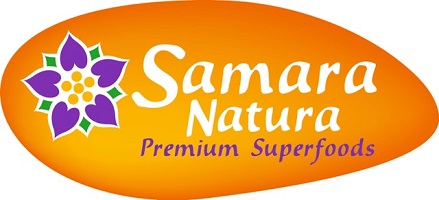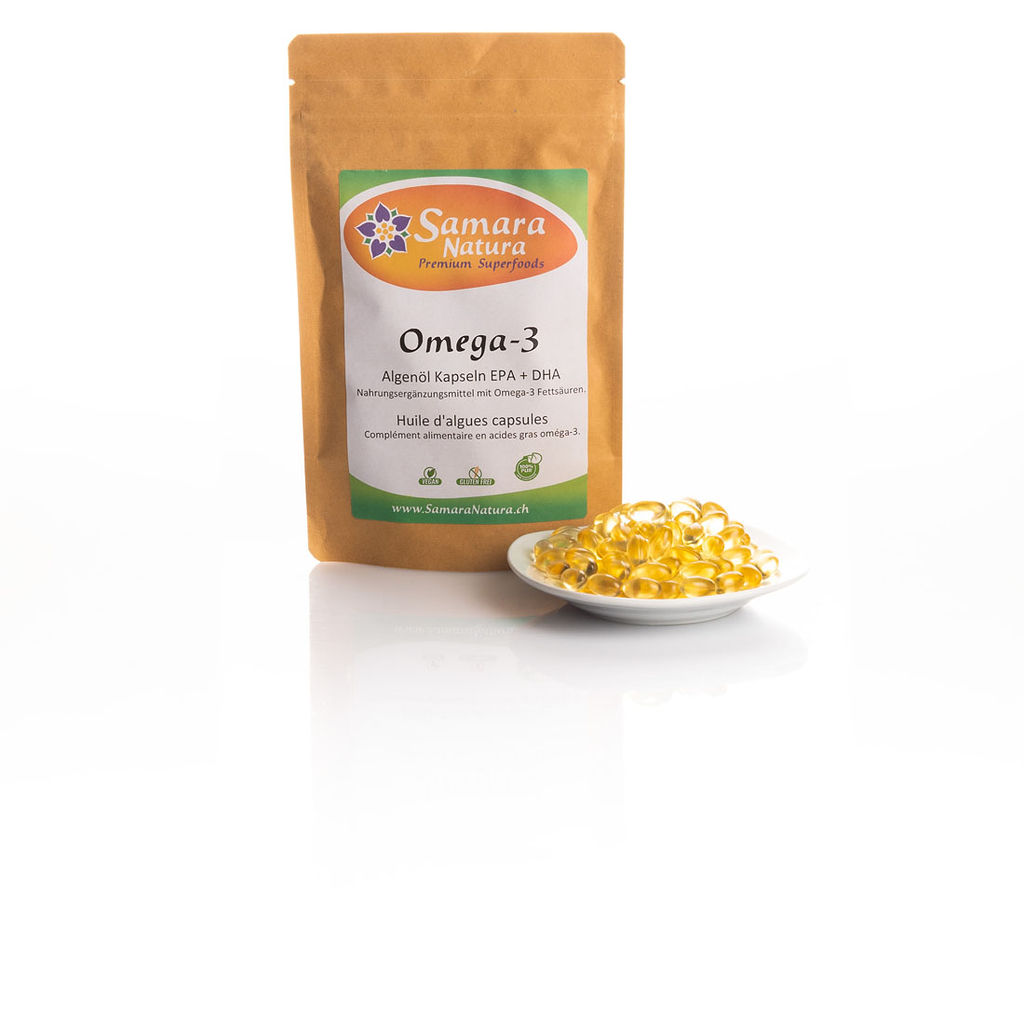Omega-3-Fettsäuren
Was sind Omega-3- / Omega-6-Fettsäuren?
Die Omega-3-Fettsäuren sind wie die Omega-6-Fettsäuren mehrfach ungesättigte Fettsäuren. Mehrfach ungesättigte Fettsäuren sind wichtige Bestandteile von Zellmembranen, die wichtig sind für die Kommunikation der Zellen und für den Stofftransport zwischen dem Zellinneren und dem extrazellulären Raum.
Was ist die Funktion der Omega-Fettsäuren?
Aus den mehrfach ungesättigten Fettsäuren werden im menschlichen Körper Gewebshormone (Eicosanoide) gebildet. Diese sind zentral bei der Regulation vieler Stoffwechselprozesse, so zum Beispiel bei der Vermehrung von Zellen, bei Entzündungsreaktionen und bei der Blutgerinnung. Omega-6- und Omega-3-Fettsäuren bilden Gewebshormone, die verschiedene und oft auch entgegengesetzte Aufgaben erfüllen. Für eine normale Stoffwechselfunktion ist eine ausgewogene Zufuhr von Omega-6- zu Omega-3-Fettsäuren zentral, das ideale Verhältnis liegt bei 4:1. Dieser Wert liegt aber ernährungsbedingt in West- und Mitteleuropa bei ca. 50:1, was zu verbreiteten Mangelerscheinungen führt.
Warum Omega-3-Fettsäuren supplementieren?
Omega-3-Fettsäuren erweitern Blutgefässe, halten sie elastisch und hemmen die Blutgerinnung, was Herz-Kreislauf-Erkrankungen vorbeugen hilft. Sie fördern so auch die Hirnleistung, da mit der verbesserten Durchblutung die Sauerstoffversorgung des Gehirns verbessert wird.
Eine gute Versorgung mit Omega-3-Fettsäuren während der Schwangerschaft hilft dem Ungeborenen, gute Augen und Abwehrkräfte zu entwickeln und Gehirn und Intelligenz zu fördern.
Wegen der entzündungshemmenden Wirkung von Omega-3-Fettsäuren sind diese hilfreich bei vielen entzündlichen Erkrankungen, wie Rheuma, Asthma, chronischen Darmerkrankungen (Morbus Crohn, Colitis ulcersosa), Neurodermitis und Schuppenflechten (Psoriasis).
Was sind die wichtigsten Omega-3-Fettsäuren?
Die wichtigsten Omega-3-Fettsäuren sind Docosahexaensäure (DHA), Eicosapentaensäure (EPA) und Alpha-Linolensäure (α-Linolensäure).
Tagesbedarf
Der Tagesbedarf eines erwachsenen Menschen an Omega-3-Fettsäuren liegt bei 500 Milligramm EPA+ DHA sowie 2g Alpha-Linolensäure.
Mangelerscheinungen
Mangelerscheinungen bei unguenstigen Fettsaeurebilanz Achten Sie auf Ihre Fettsäurebilanz um Mangelerscheinungen vorbeugen
Hauptursache für Mangelerscheinungen ist der übermässige Verzehr von Lebensmitteln mit einer ungünstigen Fettsäurebilanz, d.h. reich an Omega-6-Fettsäuren, wie Olivenöl, tierische Fette und Milchprodukte von Kühen, die mit Soja und Getreide gefüttert werden.
Typische Symptome eines Omega-3-Mangels sind Muskelschwäche, Zittern, Lichtempfindlichkeit, schuppige Haut, Konzentrationsstörungen, Wachstumsstörungen, schlechte Wundheilung, strohiges Haar, Stimmungsschwankungen, ein eingeschränktes Lernvermögen, Schlafstörungen und Depressionen.
Die Symptome für einen Mangel an Omega-3-Fettsäuren sind vielfältig und oft unspezifisch, sodass das Defizit oft erst spät erkannt wird.
Wie unterscheiden sich Omega 3, Omega 6 und Omega 9 Fettsäuren?
Um zu verstehen, warum Omega 3, Omega 6 und Omega 9 Fettsäuren so wichtig sind, müssen die Unterschiede zunächst erklärt werden.
Omega 3 Fettsäuren
Die Omega 3 Fettsäuren haben die erste Doppelbindung am dritten Kohlenstoffatom, vom Omega-Ende her gesehen. Die wichtigste Form für uns sind die Alpha-Linolensäure (ALA), sowie die Eicosapentaensäure (EPA) und die Docosahexaensäure (DHA). Die Aufgaben von Omega 3 Fettsäuren sind unter anderem die Reduzierung von Schmerzen, die Produktion von entzündungshemmenden Eicosanoiden, die Regulierung des Blutdrucks, die Steigerung der Flexibilität der Zellmembranen und vieles mehr. Um die Versorgung zu gewährleisten, müssen Omega 3 Fettsäuren über die Nahrung zugeführt werden. Der Körper stellt sie selbst nicht her.
Omega 6 Fettsäuren
Auch diese Fettsäuren sind sehr wichtig für den menschlichen Körper. Anders als bei den Omega 3 Fettsäuren, befindet sich die erste Doppelbindung bei Omega 6 Fettsäuren am sechsten Kohlenstoffarm, woher sie ihren Namen haben. Die wichtigsten Vertreter sind die Linolsäure, sowie die Aracidonsäure und die Gamma-Linolensäure. Sie sind Bestandteile der Zellmembranen, senken den negativen LDL-Cholesterinwert, leider auch den positiven HDL-Wert. Zusätzlich haben Eicosanoide eine gefässverengende Wirkung. Omega 6 Fettsäuren beeinflussen Wachstums- und Reparaturprozesse des Körpers positiv. Auch Omega 6 Fettsäuren müssen über die Nahrung aufgenommen werden, was allerdings kein Problem darstellt. Sie sind in Sonnenblumenöl, Distelöl und tierischem Fleisch enthalten.
Omega 9 Fettsäuren
Omega 9 Fettsäuren liegen am neunten Kohlenstoffatom. Sie können das Herz-Kreislauf-System, sowie den Cholesterinspiegel beeinflussen. Zusätzlich unterstützen sie die Kommunikation der Nervenzellen. Der grosse Unterschied zu Omega 3 und Omega 6 Fettsäuren ist, dass Omega 9 Fettsäuren vom Körper selbst hergestellt werden können und somit nicht zu den essentiellen Fettsäuren gehören. Es reicht die Zufuhr von gesättigtem Öl, damit der Körper Omega 9 herstellen kann.
Tipp: Omega 6 Fettsäuren werden durch die Nahrung im Überfluss aufgenommen. Omega 9 Fettsäuren stellt der Körper selbst her. Zu einem Mangel kann es also nur bei Omega 3 Fettsäuren kommen.
Wie wirken Omega 3 Fettsäuren?
Das Wirkungsspektrum von Omega 3 Fettsäuren ist sehr breit. Die wichtigste Eigenschaft ist sicherlich der bessere Schutz der Zellen gegen den Vorzeitigen Alterungsprozess. Zusätzlich haben Omega 3 Fettsäuren die Eigenschaft von starken Antioxidantien, die sogar die Blut-Gehirn-Schrank überwinden.
Das gesamte Herz-Kreislauf-System wird durch die Einnahme positiv beeinflusst. Es kommt zu einer Senkung der Triglyceridwerte, was langfristig zu einer Erhöhung der HDL-Cholesterinwerte führt. Insgesamt wird die Durchblutung verbessert und die blutverdünnende Wirkung sorgt für weniger Ablagerungen in den Blutgefässen.
Omega 3 Fettsäuren reduzieren die Bildung von Stoffen, die für zahlreiche Entzündungen zuständig sind. Somit kann eine positive Wirkung bei Rheuma, Arthritis, Psoriasis und Neurodermitis eintreten.
Ab wann besteht ein Mangel an Omega 3 Fettsäuren
Ein Mangel an Omega 3 Fettsäuren kann sich auf unterschiedliche Weise zeigen. Die Symptome sind bei jedem Menschen anders ausgeprägt. Die häufigsten Erscheinungen sind:
- Trockene schuppige Haut
- Hoher Blutdruck
- Nachlassende Sehkraft
- Schwaches Immunsystem (oft Erkältet etc.)
- Verminderte Durchblutung
- Erhöhtes Rheumarisiko
- Entstehung von Herz-Kreislauf-Erkrankungen
Wie hoch ist der Tagesbedarf an Omega 3 Fettsäuren?
Wie viel Omega 3 pro Tag aufgenommen werden sollte, ist je nach Altersgruppe unterschiedlich stark ausgeprägt. Das Verhältnis zwischen Omega 3 und Omega 6 Fettsäuren spielt hier ebenfalls mit hinein. Laut DGE (Deutsche Gesellschaft für Ernährung) sollte das Verhältnis von Omega 3 zu Omega 6 bei 1:5 liegen.
Tagesbedarf für Erwachsene
Der Tagesbedarf an Omega 3 für einen Erwachsenen liegt laut Schätzwert bei 0,5 Prozent der aufgenommenen Energie. Bei einer Energiezufuhr von 2400 Kalorien entspricht dies ca. 1,3 Gramm pro Tag. Bereits mit einem Esslöffel Rapsöl pro Tag ist diese Menge erreicht.
Tagesbedarf während Schwangerschaft und Stillzeit
Während der Schwangerschaft ist vor allem der Bedarf an DHA erhöht. Es wird eine zusätzliche Aufnahme von 200 mg DHA pro Tag empfohlen. Der vollständige Bedarf an EPA und DHA liegt demnach bei 450 mg pro Tag. Hier kann die Anwendung von Nahrungsergänzungsmitteln sinnvoll sein.
Tagesbedarf für Kinder
Der Tagesbedarf für Kinder liegt bei Kleinkindern bei ca. 100 mg Omega 3 Fettsäure. Kinder ab zwei Jahren und Jugendliche sollten 200 mg je Tag zu sich nehmen. Mögen Kinder keinen Fisch oder entsprechende Öle, kann auch die er Einsatz von Nahrungsergänzungsmitteln eine Lösung darstellen.
Tagesbedarf für Sportler
Sportler haben bei umfangreichen Trainingseinheiten einen deutlich höheren Kalorien- und Nährstoffverbrauch, als normale Menschen. Gerade die Regenerationsphase ist von der Omega 3 Aufnahme beeinträchtigt. Amerikanische Ernährungsforscher empfehlen eine Aufnahme von 1 bis 2 Gramm EPA und DHA. Beim normalen Freizeitsport reichen jedoch die üblichen 300 mg EPA und DHA pro Tag. Der Tagesbedarf an 300 mg EPA und DHA lässt sich bereits mit einer Portion Fisch von 100 bis 200 Gramm abdecken.
Die wichtigsten Lebensmittel für Omega 3 Fettsäuren
Neben Nahrungsergänzungsmitteln gibt es eine sehr grosse Auswahl an unterschiedlichen Omega 3 Lieferanten aus der Natur. Die wichtigsten Lebensmittel haben wir an dieser Stelle aufgelistet und mit dem Nährstoffgehalt an Omega 3 Fettsäuren versehen.
Meeresfrüchte
Kaltwasserfische und Meerespflanzen sind sehr gute Lieferanten für Omega 3 Fettsäuren.
Fische: - Thunfisch: 4,2 Gramm auf 100 Gramm Fisch
- Makrele geräuchert: 4,1 Gram auf 100 Gram Fisch
- Hering: 4,0 Gramm auf 100 Gramm Fisch
- Lachs: 3,6 Gramm auf 100 Gramm Fisch
- Ölsardinen: 2,8 Gramm auf 100 Gramm Fisch
Meerespflanzen:
- Phytoplankton: 1,4 Gramm auf 100 Gram Phytoplankton
Öle
In vielen Ölen steckt bekanntlich ein hoher Anteil an Omega 3 Fettsäuren.
- Leinöl: 52,8 Gramm auf 100 Gramm Öl
- Leindotteröl: 36 Gramm auf 100 Gramm Öl
- Hanföl: 25 Gramm auf 100 Gramm Öl
Nüsse
- Nüsse sind ebenfalls ein sehr guter Omega 3 Lieferant.
- Walnüsse: 7,8 Gramm auf 100 Gramm Nüsse
- Mandeln: 1,1 Gramm auf 100 Gramm Mandeln
- Pekanuss: 11,5 Gram auf 100 Gramm Nüsse
- Haselnüsse: 12,9 Gram auf 100 Gramm Nüsse
- Macadamianüsse: 16,6 Gramm auf 100 Gramm Nüsse
- Cashewkerne: 6,7 Gramm auf 100 Gramm Nüsse
Samen
Auch Samen zeigen einen sehr hohen Gehalt an Omega 3 Fettsäuren
- Leinsamen: 16,7 Gramm auf 100 Gramm Samen
- Chia-Samen: 19 Gramm auf 100 Gramm Samen
- Hanfsamen: 9 Gramm auf 100 Gramm Samen
Beeren
Die Acai Beere liefert bei ausreichender Zufuhr sehr viele Omega 3 Fettsäuren
- Acai Beere: 8,9 Gramm auf 100 Gramm Acai Pulver
Omega 3 als Nahrungsergänzungsmittel
Es gibt viele Gründe, warum jemand auf natürlichem Wege über die Nahrung nicht genug Omega 3 Fettsäuren zu sich nimmt. Teilweise gehören die Lebensmittel mit einem hohen Gehalt nicht zur täglichen Auswahl an Nahrung, teilweise ist die benötigte Menge durch Überbelastung in Sport und Beruf durch die Nahrung nicht ausreichend gedeckt.
Wenn die Ernährung nicht gesund ausgerichtet ist, kann es zu einer Unterversorgung mit Omega 3 Fettsäuren kommen. Über Nahrungsergänzungsmittel lässt sich dieser Mangel beseitigen. In Form von Omega 3 Fettsäure Kapseln ist die Aufnahme sehr leicht und kann ohne Probleme in den täglichen Ablauf integriert werden.




